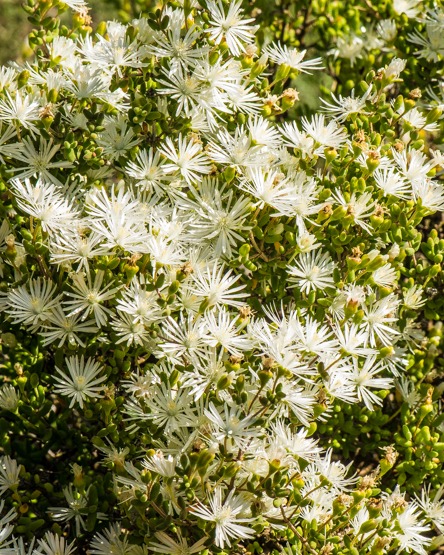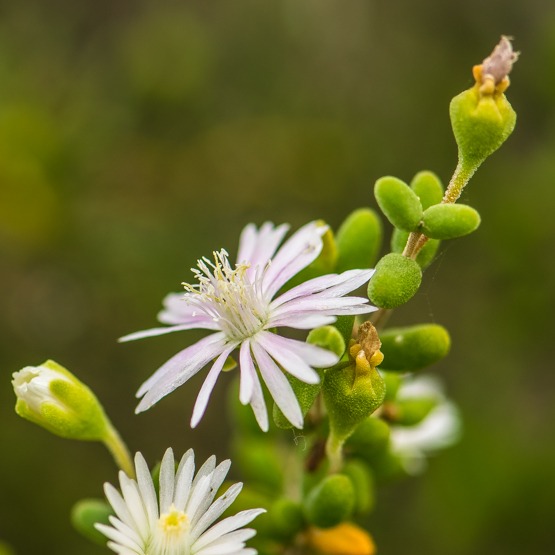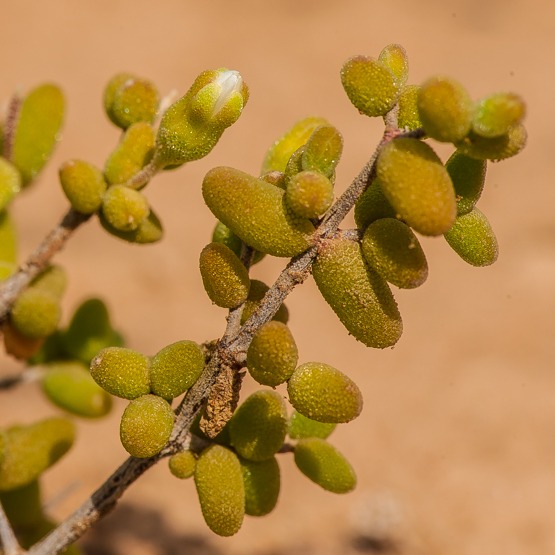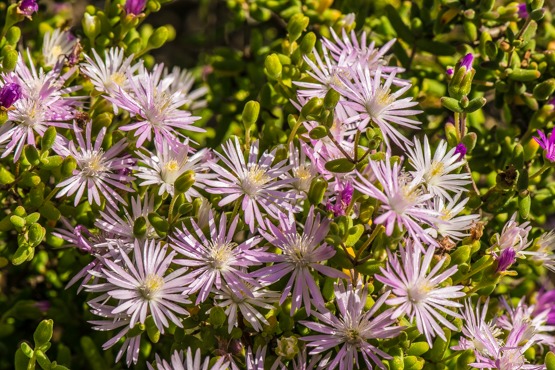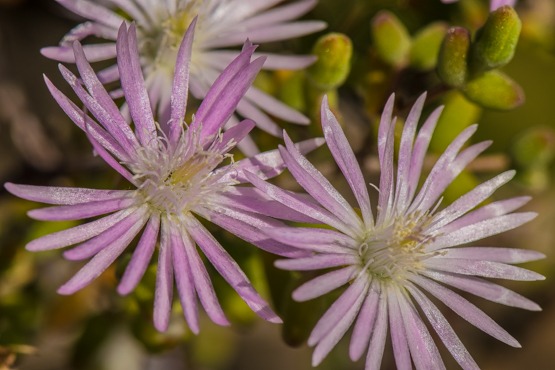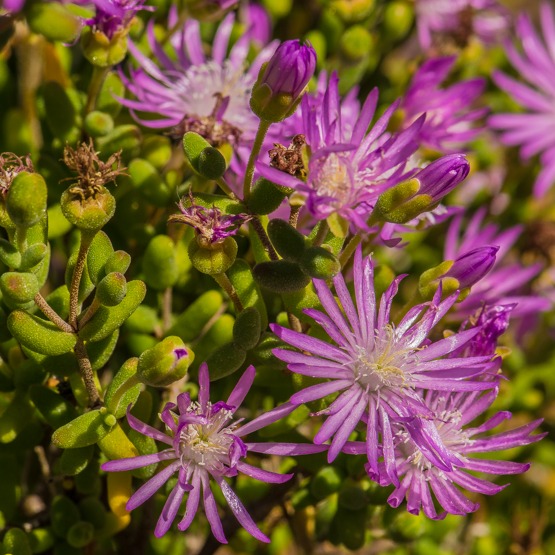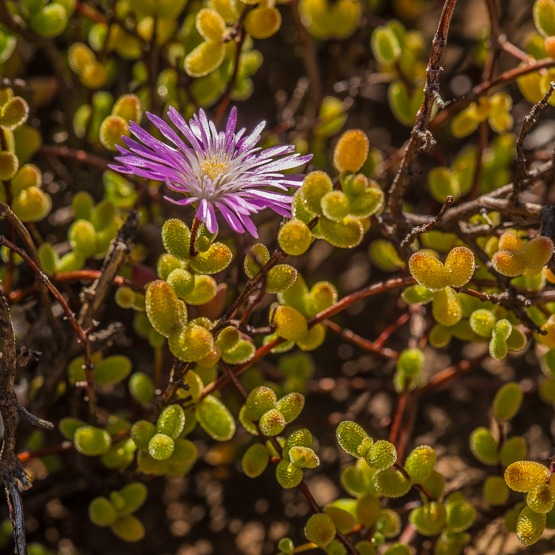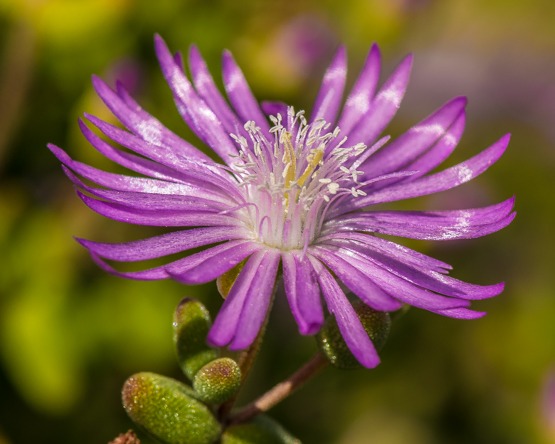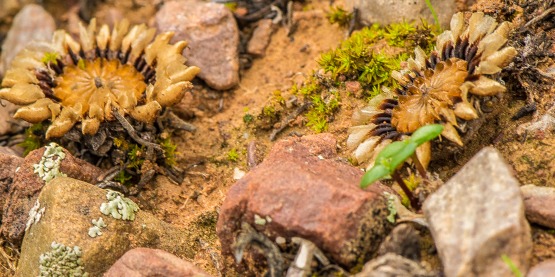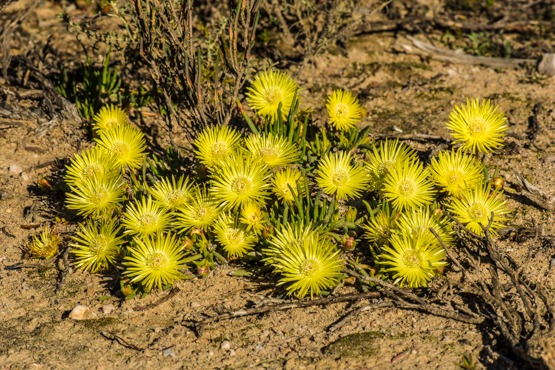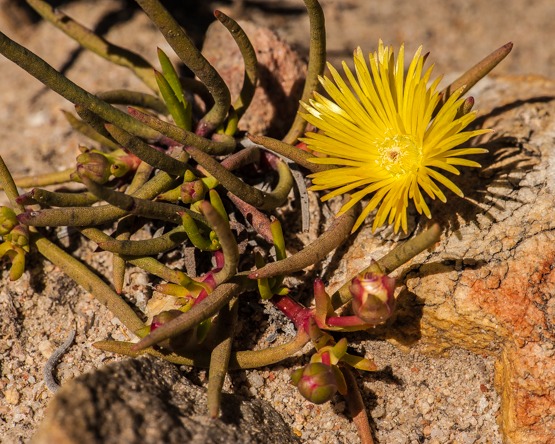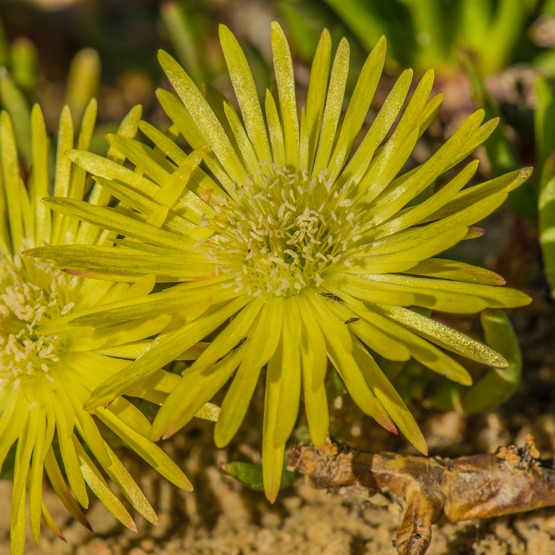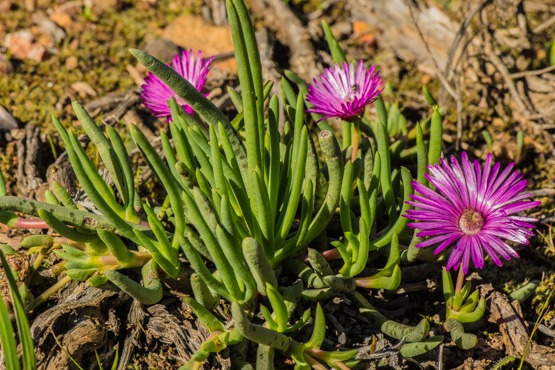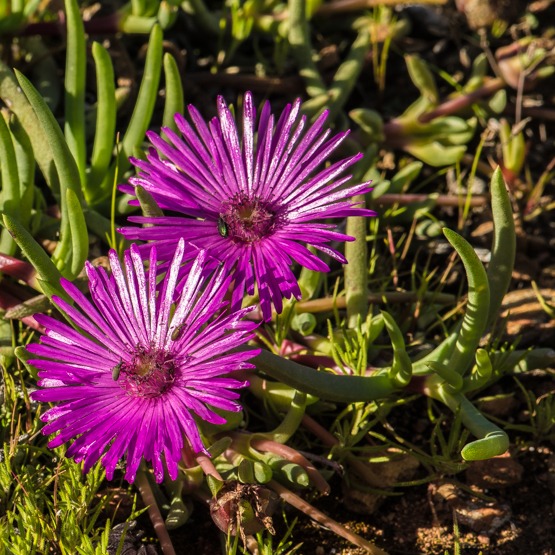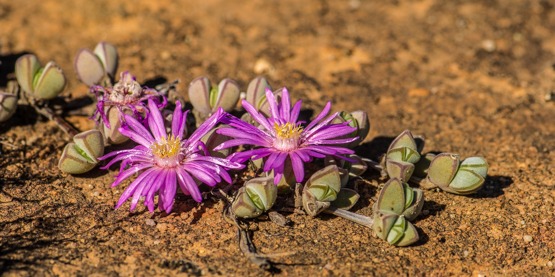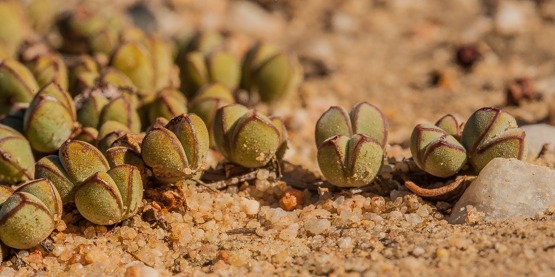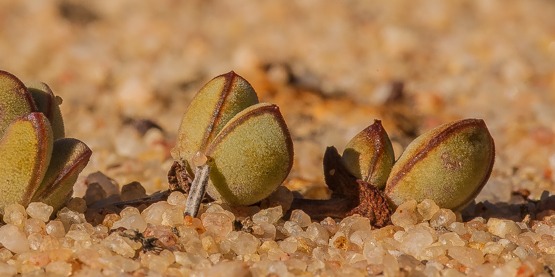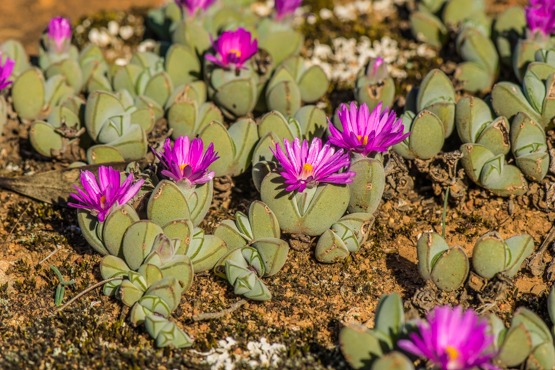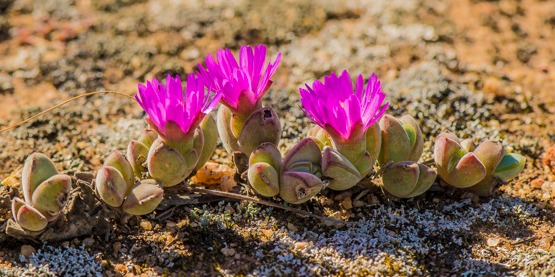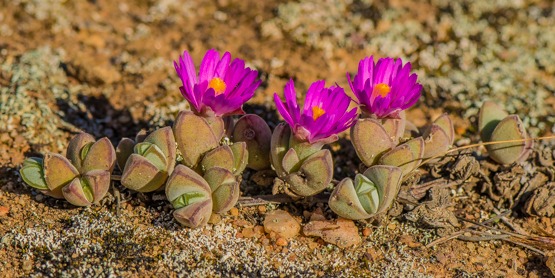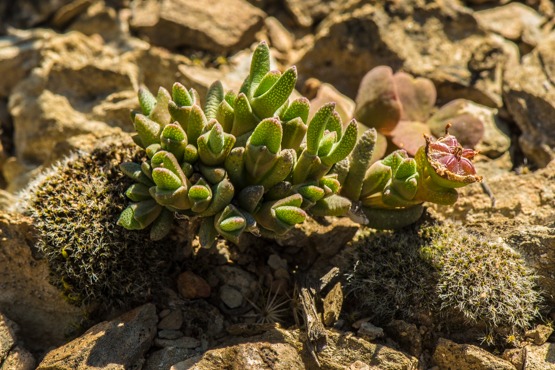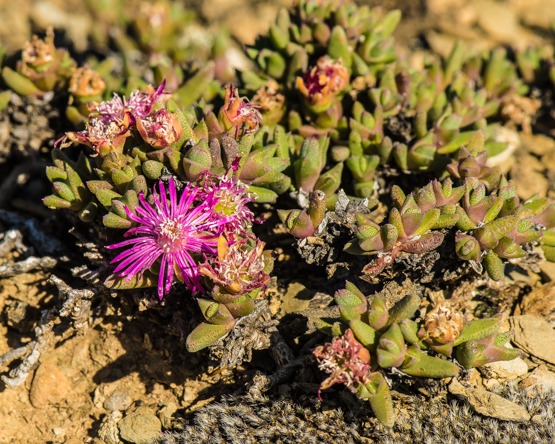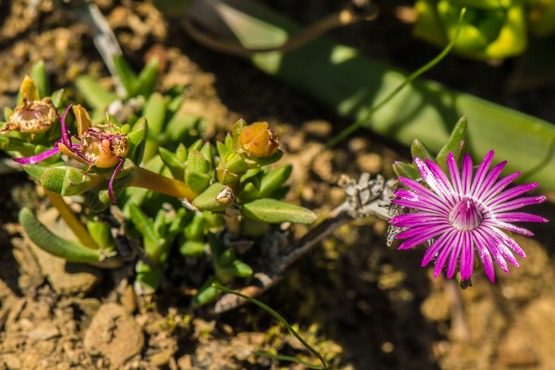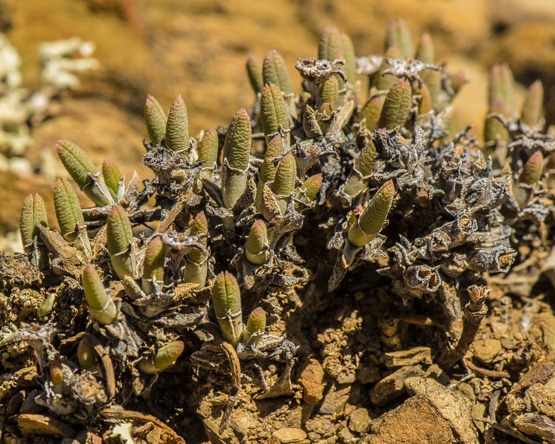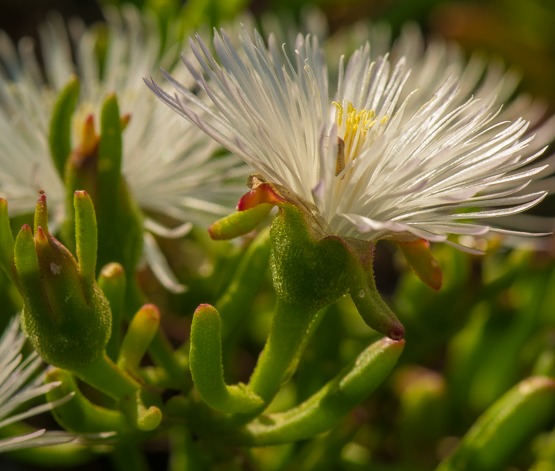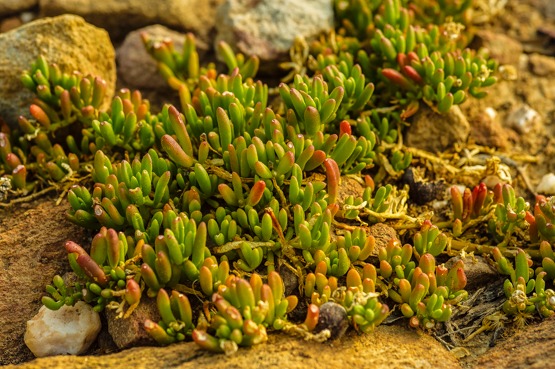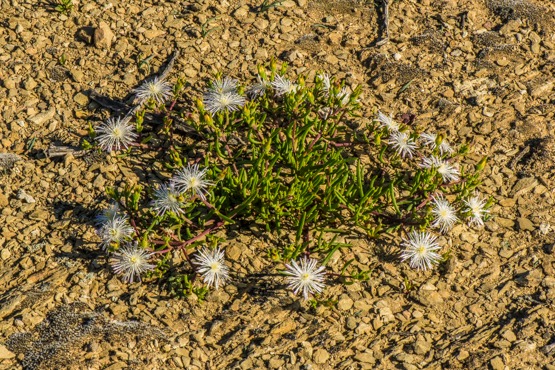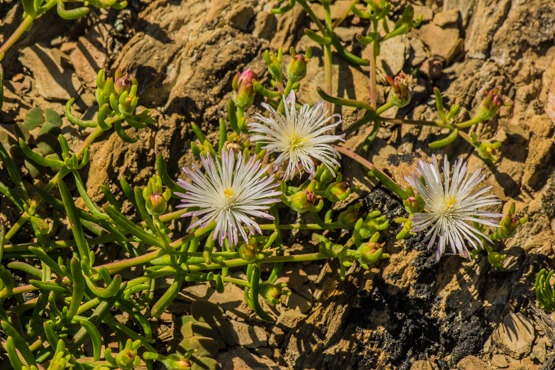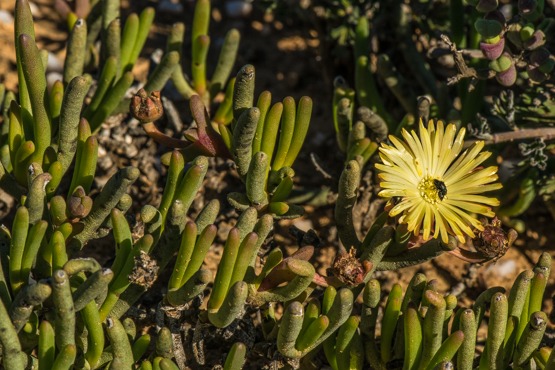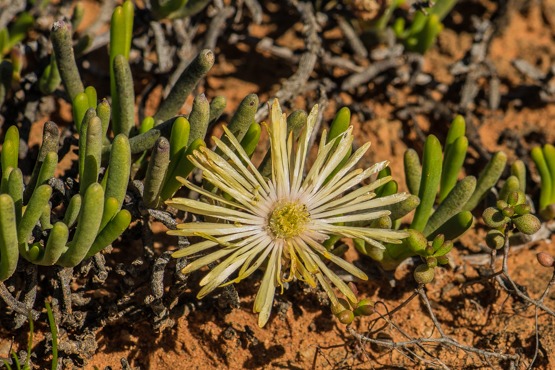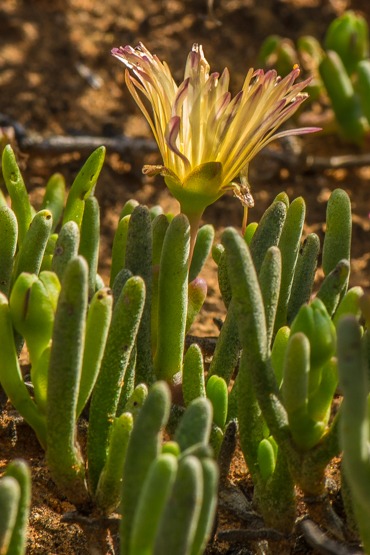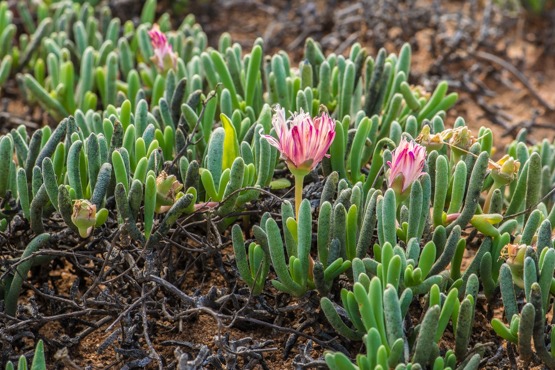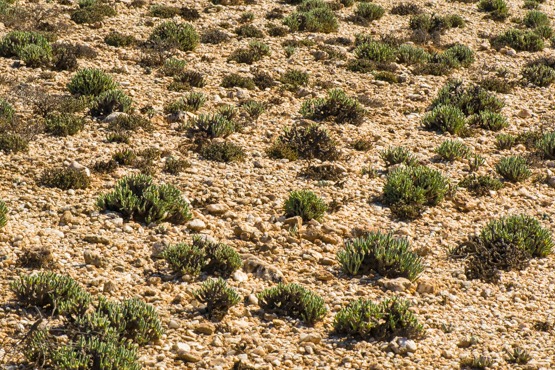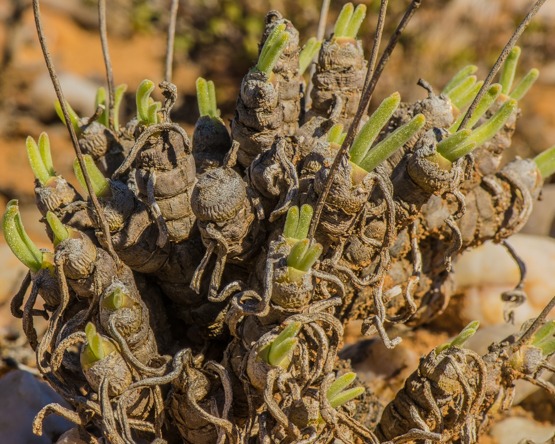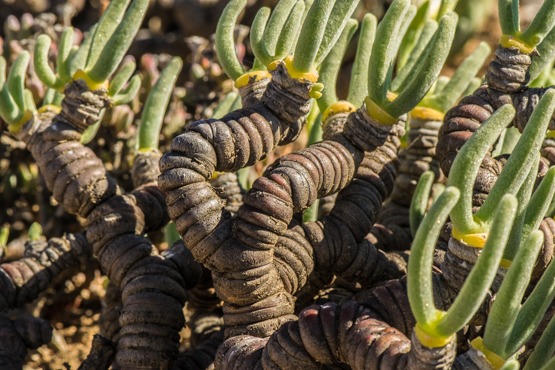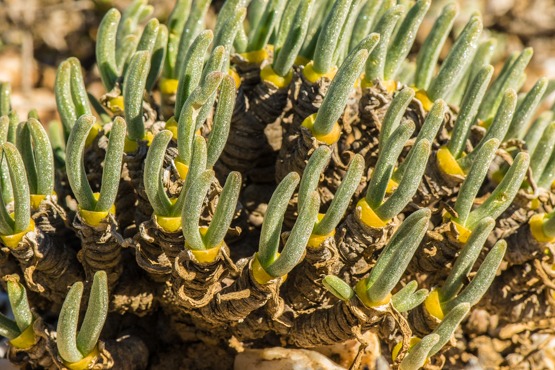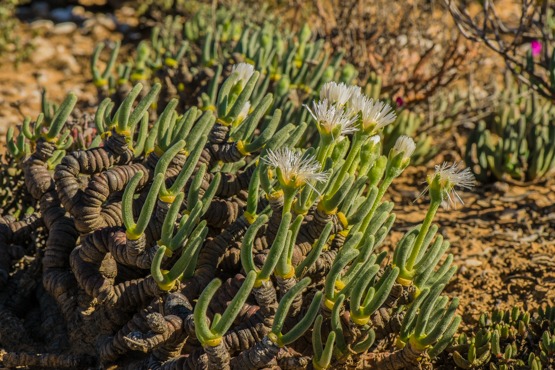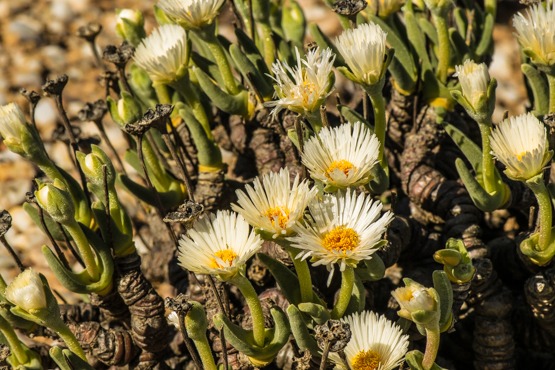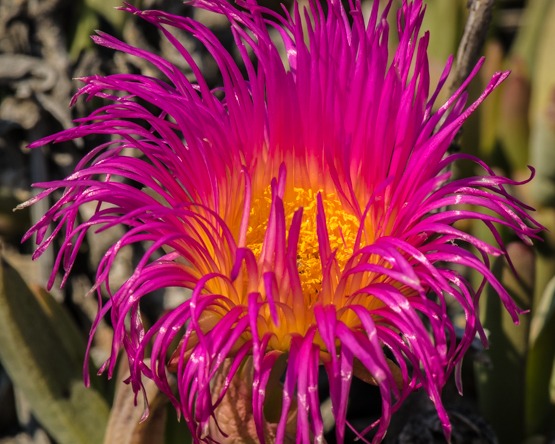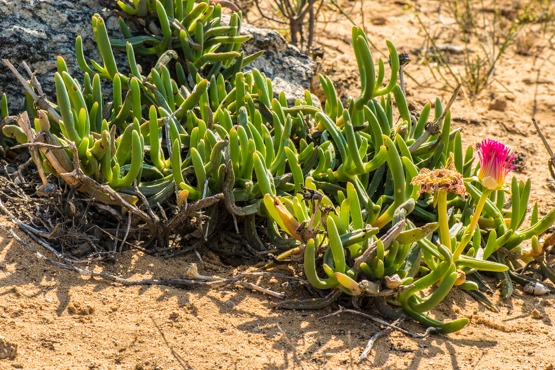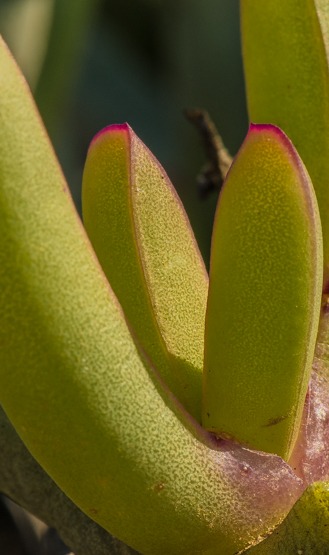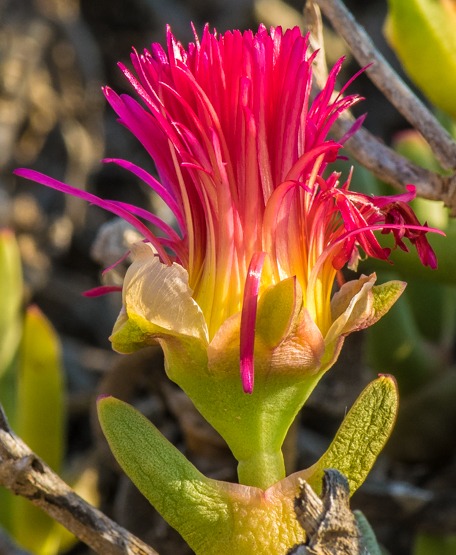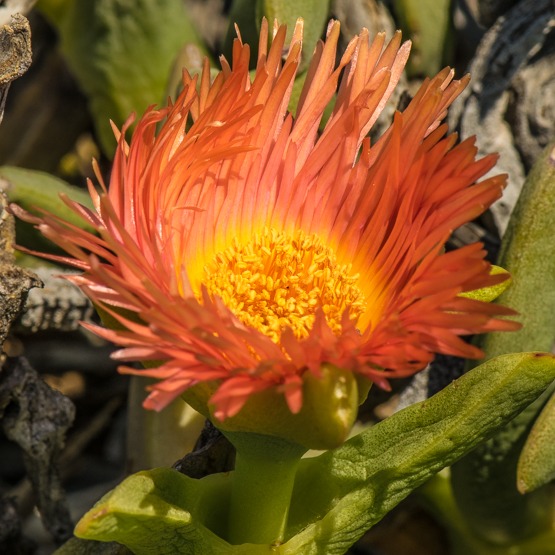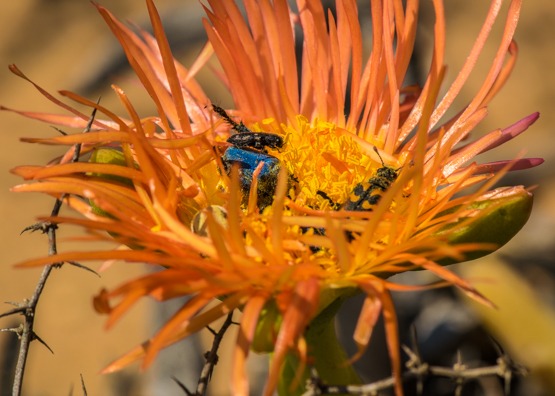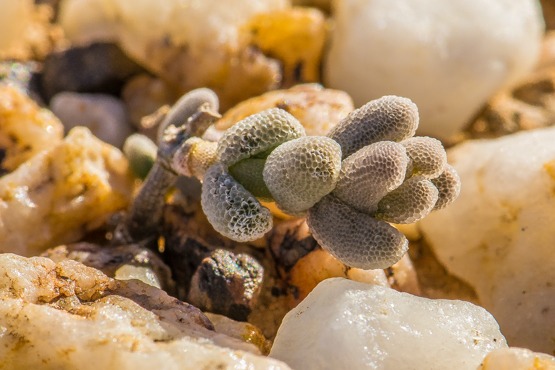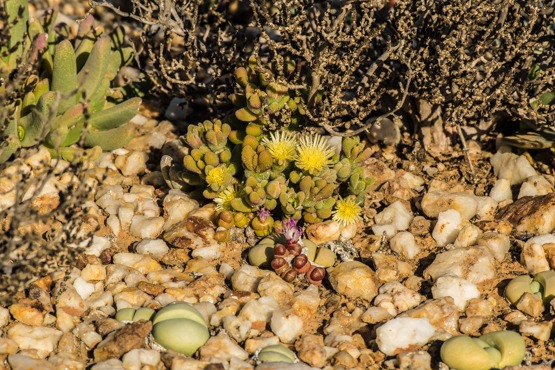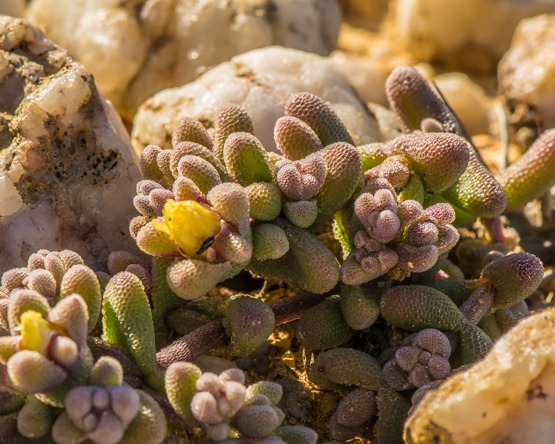The first record
In January 1906, Ms. Olive Nation found a peculiar little plant. It was growing “on the top of the Magaliesberg, 5500 ft.”, near Rustenburg (South Africa). Today, that area belongs to the Northwest province, but at that time it was part of the now-defunct Transvaal province. She sent the plant to Kew Botanic Gardens near London for identification. Unfortunately, it did not survive the trip, but from the remnants, Kew botanist N.E. Brown deducted that it had to be a new species. Ms. Nation died not long afterward and attempts to get more specimens came to nothing.
“It bears a flower so it must be a plant”
Until in 1924 Mr. and Mrs. Dobie, who lived in the same area, on a Sunday hike in the mountains, suddenly saw reddish-purple flowers that seemed to grow directly from crevices in the rocks. Upon further examination, the flowers were found to be attached to small plants, consisting of 6 to12 short rods that were almost completely covered by the flowers. “Here’s something for your collection. It bears a flower so it must be a plant, Mr. Dobie is believed to have told his wife.
The first description
Mrs. Dobie sent a specimen to Frank Frith (1872 – 1954) in Johannesburg, a botanist who worked for the South African railways. Frith also came looking for it himself and he submitted some of the collected plants for the ‘South African Rockery’ of the Wembley Exhibition of 1924 (a kind of World Exhibition).
On December 10, 1924, Frith wrote to Mrs. Dobie:

That professor was the famous Nicholas Edward Brown, who worked in Kew from1873 until his death in 1934. In the 1920’s he separated many genera from the ever-expanding genus Mesembryanthemum. In the identification key he published in the journal ‘Gardeners’ Chronicle’ in November 1925, the generic name Frithia first appears. The description of the only species in that genus, F. pulchra, followed in 1926. He named the genus Frithia, to honor Frank Frith. In view of the above, it would have made more sense to call it Dobiea. The species name pulchra, by the way, is derived from the Latin pulcher = beautiful.
The original material collected and supplied by Frith is still present in Kew’s herbarium (fig. 1).

Brown added an exclamation mark after his remark that the flowers of this plant lasted for up to three weeks.
The first published image
The oldest image known to me appeared in 1927 as record 275 in the seventh part of the magazine ‘The Flowering Plants of South Africa’ (fig. 2).

This magazine, published annually since1921 and edited by I.B. Pole-Evans, is reminiscent of the well-known ‘Curtis’s Botanical Magazine’: always a botanical drawing with many details on a full page, followed by a text of 1 to 2 pages. In this way, 40 plants were depicted and discussed each year. F. pulchra’s drawing was created by botanical artist Beatrice Orchard Carter; the text accompanying the image is by Louisa Bolus.
Rapid integration
Amazingly, the species – of which only one locality was recorded at the time – quickly became widely known. As early as 1927, a slide of a F. pulchra in bloom was displayed at a meeting of the ‘s Gravenhage (Netherlands) branch of the succulent plant lovers’ association Succulenta. In 1928, Mr. E.J. Labarre (member of Succulenta since its inception in 1919) wrote an article in the weekly magazine ‘Onze Tuinen’ about Frithia. He had received plants from Mrs. Dobie himself and donated a seed tray full of them to the Botanic Garden of Amsterdam. In the same year, an article by the same writer appeared in the monthly magazine ‘Succulenta’, titled “The Frithia blooms!” with a picture of another seed pan, this time with flowering plants. With this exhibit, Mr. Labarre won a certificate of merit at the show of the Amsterdam Hortus. He added: ‘The finder, Mrs. Dobie, has always called them ‘Fairy Elephants’ Feet’. Isn’t that a suitable name for those who are romantically inclined?”
The name Fairy Elephants’ Feet is still used. In South Africa the plant is also referred to as ‘Bobbejaanvingers’ (a bobbejaan is a baboon), ‘glasies’ (glasses), ‘toontjies’ (toes) and ‘Baby Toes’. Also called ‘Purple Baby Toes’ to distinguish it from the Fenestraria’s, which look like it and are also called ‘Baby Toes’ but have white or yellow flowers.
Occurrence in nature
The plant also became a popular species in South Africa itself. This is evident from a comprehensive report in ‘Succulenta’ (8 pages) of a trip by Mr. F.W. Reitz of Pretoria in1935 from his hometown to the Rustenburg Gorge. Below are some of the passages from his report:
Being a passionate succulent collector, I already consider myself owning an extensive collection of succulents and also some rare cacti. However, the heavy rains of last November have ruined all my Frithia pulchra, so I planned to search for some of those beautiful plants.
A little further, diagonally opposite Rustenburg Gorge, lives Mrs. Dobie, the discoverer of Frithia pulchra. I know her well and had promised her I would come and see her collection of rare succulents.
That fine rose flower on the crystal-white quartz grit was the purpose of our trip, Carefully I wiped away the gravel, and only then did the characteristic rods emerge, with their transparent windows that absorb the sunlight, since the plant itself does not expose itself in order to protect itself from the drought. With long spikes, which Mrs. Dobie had supplied, we managed to remove the plants from the crevices: it had to be done very carefully because they were well secured, and the Frithias are very delicate. When I removed the gravel over a greater surface, it turned out that the ground was literally dotted with Frithia pulchra, and that without realizing it, we had walked over them. But it is remarkable that only on those flats covered with fine gravel and in solid rocks this special succulent could be found. Dry, intensely dry, it has to be there. And the power of the sun at 4500 feet (1372 m) above sea level, where the average winter temperature is 58° F. (14 °C), the average summer temperature is 72° F (22 °C)., and the average annual rainfall is only 25 inches (635 mm), must be very strong.
The removal of these petite plants was not easy, but in the course of half an hour, we had more than 100 of them together. Carefully they were packed in a bag, and, glad to have achieved our goal, we made our way back.
Before packing the car and setting out on the return journey, I filled two flour bags with pure white quartz gravel. This came in handy, because I now keep my Frithia pulchra in a box, in which I have tried to imitate the natural conditions at the site on the mountain as faithfully as possible. Yet I have failed to keep the whole treasure alive. Within a week, about 50% of my Frithias suddenly dried up. The rest, on the other hand, is safe and sound. I am very satisfied with the result. Frithia pulchra possesses the same property as many other aristocratic plants, i.e. that they are very difficult to replant and very peculiar about unaccustomed living conditions: too much water, too rich soil and too little gravel can be the cause of Frithia pulchra’s death.
So much for Mr. Reitz’s account. This story clearly shows that you can easily overlook the plants.
In figure 3 we see what looks like a piece of land with some grassy plant growth. But in reality, it’s full of F. pulchra. Within the red circle, there are three clusters.

Fig. 3. Locality somewhere southeast of Rustenburg. In the indicated area there are 3 clusters of Frithia pulchra. Photo Werner du Toit
Figure 4 shows the same site with a corresponding circle.
Fig. 4. Many specimens of Frithia pulchra among quartz gravel and in crevices, with the same area encircled as in fig. 3. Photo Werner du Toit
These photos by Werner du Toit were taken on January 28, 2017, in the middle of the growing period. In the dry season (winter), the plant tissue contracts due to dehydration and so the plant bodies are even pulled completely into the ground. The quartz gravel in which the plants grow can become very hot in summer. In harsh winters it may freeze there. In summer it can rain heavily and the plants clearly enjoy that. Flowering in South Africa also takes place in summer (December through February).

Nature conservation
Fortunately, in these times people no longer work as described above by Mr. Reitz. On the IUCN Red List of Threatened Species, F. pulchra has the status of ‘vulnerable’. The distribution area is limited to a number of localities in the Magaliesberg region and is estimated to be less than 5 km2. The biggest threat is illegal collection, but it is assumed that this has not had a major impact on the occurrence of the species. The populations are stable. The fact that the plant is easy to grow and that plants collected in the wild usually die may play a role in this. The area of the Magaliesberg is now a protected nature reserve, the Magaliesberg Protected Environment (MPE). It runs roughly from Rustenburg to Pretoria.
The genus Frithia
As mentioned above, the genus Frithia was established in1925. Today it is one of more than 120 genera in the Ruschioideae, one of the five subfamilies of the large family of Aizoaceae (the ice plant family). The grouping into genera is based, among other things, on the construction of the seed capsules and therefore not easy to understand for the average enthusiast. The genus Frithia however is easy to tell apart from the genus Fenestraria – which at first glance bears a lot of resemblance to Frithia – by the way the leaves are arranged. In Frithia, the leaf position is spiral, whereas in Fenestraria the leaves are placed crosswise. Also, in Fenestraria the leaf surface is smooth, whereas in Frithia it is divided into tiny lens-like structures (fig. 6 and fig. 7).


In his 1925 description of both genera, Brown commented that the leaf surfaces do not contain chlorophyll. He indicated that you can easily ascertain this by cutting off the top of a leaf and looking at it against the light. This works, but it’s also quite destructive.
A second species
Brown knew one species: F. pulchra. In 1968 H.W. de Boer described in ’Succulenta’ some different plants that he had received from a C.G. Booker in Transvaal. The deviations concerned the much smaller leaves and flowers, the colour of the leaves (“rose-like greenish-brown”), and the colour of the flowers (white with the tips of the petals tinted rose-violet). The locality could not be established because Mr. Booker had since died. De Boer described this form as F. pulchra var. minor (= smaller). Because no material was deposited in a herbarium, the description is invalid. In the year 2000 Patricia Burgoyne et al. described the plant as a new species: Frithia humilis. According to the dictionaries, humilis means low or near the ground, but according to Burgoyne it is ‘smaller than others of its kind’. One of the photos accompanying the 1968 article by de Boer is now the lectotype of F. humilis.
Bronkhorstspruit, about 50 km east of Pretoria, is indicated as locality (fig. 8 and 9).


Fig. 9. Frithia humilis north of or Bronkhorstspruit in bloom. Photo Sean Gildenhuys
It is worth noting that Louisa Bolus in ‘The Flowering Plants of South Africa’ mentions that the South African lawyer and plant collector Douglas Gilfinnan had already found F. pulchra at the place Witbank at the end of December 1905, just a few weeks before Mrs. Nation. That is about 200 km east of Rustenburg and about 40 km east of Bronkhorstspruit. This may also be F. humilis.
Cultivation
In cultivation, we grow Frithia pulchra with its leaves above the ground. The risk of rot is high if we don’t. The soil should be granular and well permeable with a small proportion of organic matter. Keep absolutely dry in winter. The plants will certainly start to shrivel then. In spring, light misting is recommended. Once the plants are filled out, you need to water them regularly. The plants should not start to shrivel during this time. Flowering time occurs with me in the Netherlands in June-July. It is wise to limit the amount of water afterward, because the growing period is rather short.

Propagation by sowing works fine, but is also possible by cuttings. This is done by carefully dividing a rosette in half and planting the pieces after the wounds have dried. But don’t do this if it’s your only plant, as there’s a good chance of rot occurring.
Literature
Boer, H.W. de (1968). Frithia pulchra var. minor 47: 147.
Bolus, L. (1927) Frithia pulchra, The flowering plants of South Africa 7: text accompanying plate 275.
Brown, N.E. (1925). Mesembryanthemum and some new genera separated from it. The Gardeners’ chronicle 78: 433.
Brown, N.E. (1926). Ficoidaceae in J Burtt Davy, Manual of the Flowering Plants and Ferns of the Transvaal 1: 41, 162.
Burgoyne, P.M. & Smith, G.F. & Plessis, F. du. (2000). Notes on the genus Frithia (Mesembryanthemaceae) and the description of a new species, E humilis, in South Africa, Bothalia 30 (1): 1 – 7.
Labarre, E.J. (1928). De Frithia pulchra, of romantiek in de botanie, Onze tuinen 23 (6): 61.
Labarre, E.J. (1928). De Frithia bloeit!, Succulenta 10 (12): 215 – 219.
Reitz, F.W. (1935). Frithia pulchra, Succulenta 17 (6): 81 and 17 (7): 97.
First published in Succulenta 99 (2), 2020. Translated from the Dutch by F.N.

